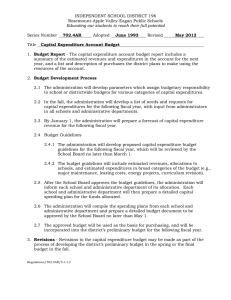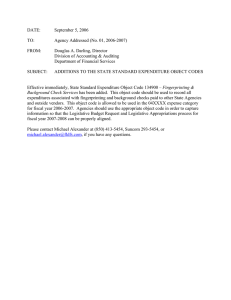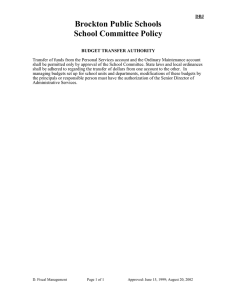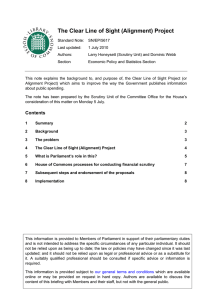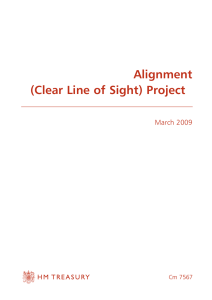Clear line of sight: Aligning budgets, Estimates and accounts
advertisement
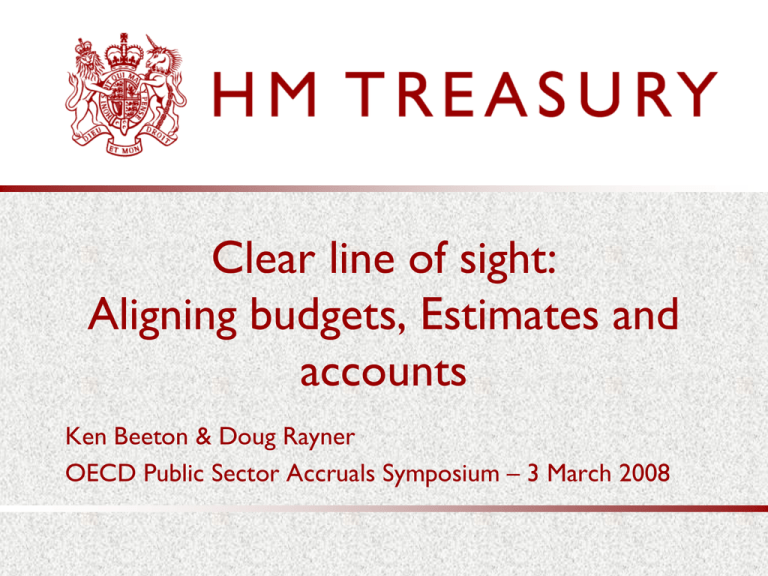
Clear line of sight: Aligning budgets, Estimates and accounts Ken Beeton & Doug Rayner OECD Public Sector Accruals Symposium – 3 March 2008 The opportunity (1) “The Government will simplify its reporting to Parliament, ensuring that it reports in a more consistent fashion, in line with the fiscal rules, at all three stages in the process: on plans, Estimates and actual expenditure outturns” “The Governance of Britain” July 2007 2 The opportunity (2) “We recommend that the Government … replace the current system of authorisation based primarily on Estimates with one linked more clearly with the public expenditure planning and control system, so that the House of Commons would … authorise Departmental Expenditure Limits and … Annually Managed Expenditure” Treasury Committee Report on the 2007 CSR, June 2007 3 The problem we’re aiming to solve • • Different bases on which financial information is presented to Parliament and other stakeholders Government financial documents published in different formats, on many different occasions: - different sets of numbers - makes spending control and Parliamentary monitoring more difficult - value for money incentives are weakened or non-existent - accountability not straightforward – makes public debate more difficult - burdensome and costly 4 The different frameworks, and the purposes they serve The various frameworks have different purposes and rules: National Accounts: the fiscal rules are measured by reference to the National Accounts Budgets: are used to control public spending and need to align with the National Accounts to support the fiscal rules Estimates: seek annual Parliamentary authority for departments’ spending that isn’t authorised elsewhere Resource Accounts: report departments’ actual spend for the year on a ‘commercial’ basis, adapted for the public sector, and compare outturn with Estimates 5 The problem we are trying to solve – Budgets, Estimates & Accounts Less than 0.1 -0.1 0.2 Budgets Estimates 346 35 Amounts included under each system (£ billion) 184 -5 Resource Accounts 6 The problem we are trying to solve – Reporting PUBLICATION DATE PUBLISHED Spring/Summer publications Main Estimates Apr/May (5 weeks after Budget) Supplementary Budgetary Information (SBI) Apr/May (5 weeks after Budget) Public Expenditure Statistical Analyses (PESA) Apr/May (5 weeks after Budget) Departmental Reports May (just after Main Estimates) Summer Supplementary Estimates June Departmental Resource Accounts June/July Public Expenditure Outturn White Paper (PEOWP) July Autumn/Winter publications Autumn Performance Reports (APRs) November Winter Supplementary Estimates November Vote on Account November Spring Supplementary Estimates February Statement of Excesses February 7 What success might look like – Developing the Vision “To create a single, coherent financial regime, that is effective, efficient and transparent, enhances accountability to Parliament and the public, and underpins the Government’s fiscal framework, incentivises good value for money and supports delivery of excellent public services by allowing managers to manage.” 8 What success might look like – what this Vision would mean Significant benefits of better alignment: • • • • • • A simpler and more transparent system, with a single set of numbers that can be tracked through the system from start to finish A significantly enhanced ability to control public spending in line with Government’s controls and the way departments manage themselves Improved risk management and stronger value for money incentives Two or, at most, three main documents presented to Parliament by departments each year Better government, through improved democratic involvement for, and accountability to, Parliament and the public Cost effective financial regime, with no unnecessary burdens 9 The “Top Down” Approach Flexibility may be needed in some areas: • Can we meet the fiscal rules in other ways? • Are adaptations to IFRS acceptable in some areas to achieve alignment? All misalignments must be challenged rigorously, and not pursued only if result would cause serious damage or be manipulable Any necessary residual reconciliations must be as simple as possible 10 Next Steps • Steering Committee and Project Board in place • Timetable – aiming to: - complete detailed project planning by March 2008, including early identification of legal risks - 2008-09: negotiate design of new operating model, leading to possible consultation paper - 2009-10: implementation planning - 2010-11: commence delivery (possibly phased), subject to resolving legal and other issues 11
